Carol Beth Anderson's Blog, page 5
February 27, 2019
Working with Early Readers, Part 2: BETA READERS
This is Part 2 of a series for indie authors.
To read the series intro, click here.
To read Part 1: ALPHA READERS, click here.
How many beta readers should you have? Some people say one or two; others say as many as you can get!
I used to be in the latter camp, but when I had over twenty beta readers for one book, I did find it a bit overwhelming. I think twenty is probably my max, but you’ll have to figure out what works for you.
I got a lot of inspiration for my beta reading system from one of my favorite authors, Michael J. Sullivan, and his wife Robin. Robin runs an amazing beta team for Michael. I’m not on that team, but in Michael’s newsletter, they’ve been kind enough to share how their beta reading process works.
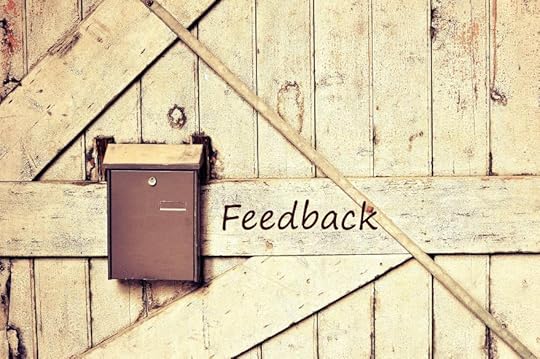 Image source: pixabay.com
Image source: pixabay.comLet’s jump in!
Here’s are two keys to a successful beta reading round:
Provide betas with a manuscript that, while imperfect, is already in good reading condition. Typos, grammar issues, and plot issues will exist, but they shouldn’t be so egregious that your beta readers don’t even want to finish the book!Communicate, communicate, communicate. Then communicate some more. People are busy. You’ve got to help them remember their commitment to beta read, and give them enough guidance to do so successfully!
Where can I find betas?
As with alpha readers, I started with people I knew! Sure, they weren’t all fans of the genre, but they were people willing to read my work. You gotta start somewhere!
I started a newsletter (mostly friends and family from Facebook) and asked my subscribers to apply as beta readers.I asked on my personal Facebook page.I started a Facebook author page (again, mostly friends and family) and asked there.Once I’d been through this process on one book, I sent special requests to former betas to repeat their roles.I’ve also invited people on Twitter to apply as beta readers.When I request beta readers, I try to be very specific about what I’m asking. Check out this newsletter to see what I mean.
How my beta-reading process works:
Prospective beta readers fill out a beta reader application. Here’s the one I used for Birth of Magic.Just filling out the application shows a certain level of commitment! So in the past, I’ve accepted everyone who filled out the application. However, from now on, I’ll be more selective if I get more than 20 applications.Even if I communicate very well with beta readers, I only get feedback from about 2/3 to 3/4 of them.Once I’ve chosen my beta team and the book is ready, I send each of them an intro e-mail. I’m very clear on their deadlines (usually four weeks for a novel and at least two weeks for a novella) and what I’m looking for. Here’s my intro email for Birth of Magic:
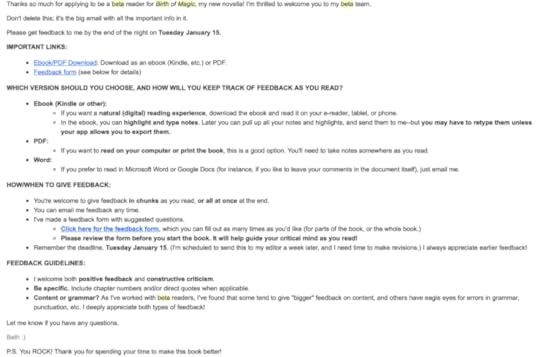
As you can see above, I give beta readers a feedback form. It’s optional, but most of them use it, and it really helps me get useful feedback! Check out my Birth of Magic beta feedback form.I try to email my beta readers about once a week through the process, reminding them of the deadline. I always do this as a response to the original email so that they can look back at all the info I shared originally. I respond to every person who gives feedback, giving them my heartfelt gratitude…even if the feedback was overall negative. Sometimes (definitely not always), I respond to individual suggestions, letting them know the direction I’m going, so they feel like I’m taking the suggestions seriously. I incorporate beta feedback in my next big revision round.
How I decide which feedback to incorporate:
First, I go with my gut. Does the feedback feel right? If it does, I change it.If more than one person has the same feedback, I might change it, even if it didn’t initially strike me as necessaryAnd of course I change grammar errors, typos, etc. that my betas find!
Once you’ve made revisions based on beta feedback, it’s time for final polishing. That might involve a professional editor and/or proofreader, or an additional read-through by you, the author, or even another beta round…whatever you need to get your book ready for ARC reviewers.
Click here for Part 3 of this series: ARC reviewers.
Author Resources on my website are 100% free. But if you’d like to buy me a coffee to thank me, click the button!
Working with Early Readers, Part 1: ALPHA READERS
This is Part 1 of a series for indie authors. To read the series intro, click here.
Finding critique partners or alpha readers can be scary! Your book is your baby, but you know it’s pretty rough because it’s in early-draft phase. Sharing it requires vulnerability. However, I’ve found my alpha team immensely valuable in crafting better books.
If you’re just starting out, it may work best to gather one or two trusted friends or family members (who will give you honest feedback) to be your alpha readers. Give them chapters or chunks of the book as you write it, and get their feedback.
My most faithful alpha readers at first were my sister and my mom. My sister in particular has a good eye for story issues and gave me a lot of extremely valuable feedback.
People will say, “Don’t ask friends and family for critiques! They won’t be honest!” But I say, start with what you’ve got! You’re a new author–you don’t have a fan base yet. But you do know people!
However, there are also ways to connect with other writers. I find Twitter to be an amazing writing community. (I’m @CBethAnderson.) Hop on, introduce yourself using the hashtag #WritingCommunity, and find some friends. Maybe some of them can be your alpha readers or critique partners!
Now that I have books released, I have a private Facebook group for my alpha readers. (I tried this method when I started writing, but it really didn’t work well. It was easier to build an alpha community once I’d earned their trust by publishing a trilogy they enjoyed!)
 Photo by freestocks.org from Pexels
Photo by freestocks.org from PexelsHere are the details of how I work with alpha readers:
Where can I find alpha readers?
At first, I invited my street team (see below) to be alpha readers. I was honest with them: “You’ll be reading books in chunks, which isn’t always a satisfying way to read. It’ll be rough, with lots of errors!”People joined my alpha reader group. After several months, I reached out to anyone who hadn’t given feedback to ask if they still wanted to be in the group. I took out those who decided it wasn’t for them (no hard feelings.)Now, my alpha reader group is invitation-only. After I culled the inactive members, I invited a few excellent beta readers I thought would make good alpha readers.
How alpha reading works in my Facebook Group:
I post instructions in the group. I tell them I’m looking for “big picture” feedback at this phase, such as plot pacing, characterization, and worldbuilding. I don’t want feedback on grammar or typos; it’s too early to worry about that stuff!When I’ve completed about 1/4 of a book (1/2 if it’s a very short novella), I format it as mobi (for Kindle), ePub, and PDF (print version). The formatting software I’ve chosen is Vellum (Mac-only), but there are free options, such as Draft2Digital. (Yes, you can distribute in other forms, such as Word or Google Docs, but I find most readers prefer to read on a device, and ePub and mobi are ideal for that.)I use BookFunnel to create a page where my alpha readers can download the partial manuscript. (MyBookCave is another option. It’s more complicated to use for this purpose, but it’s free.)I share the download link in the private Facebook group and encourage people to read and review. I tag everyone in the group when I post so they don’t miss it!Alpha readers give feedback within the Facebook group. That way, we get into some good conversations. The readers often agree with each other, and sometimes they disagree. All that is helpful to me!I always respond to feedback, thanking the alpha reader and usually addressing specific elements of their feedback.As I read, I continue to provide the book to readers a quarter at a time. (But when I publish the second quarter, I also include the first quarter, so someone who hasn’t started reading yet has it all in one place.)I use a ton of this feedback as I revise for beta readers, and sometimes I update alpha readers on how I utilized their specific feedback!
Speaking of beta readers, click here to go to Part 2 of this series: BETA READERS.
Author Resources on my website are 100% free. But if you’d like to buy me a coffee to thank me, click the button!
Working with Early Readers (Alpha, Beta & ARC): A Blog Series for Indie Authors
Hi, fellow indie authors!
I still have a whole lot to learn as an indie, but I know one thing I’m good at. Well, three things, actually: my systems for working with alpha readers, beta readers, and ARC reviewers.
Using these systems, I end up with a quality finished product that has already incorporated a lot of reader feedback, and I get a good number of early reviews, giving me “social proof” on Amazon and Goodreads.
I’ll share these systems with you in this blog series.
 Photo by Perfecto Capucine from Pexels
Photo by Perfecto Capucine from PexelsFirst, some definitions:
Different people use the terms alpha readers and beta readers in different ways. Here’s how I use those terms:Alpha readers read my manuscript as I’m writing it, and then they give me feedback on chunks of it. Essentially they’re reading the first draft (though I do read through chapters once before moving on, so it’s more like a second draft.) Beta readers read my manuscript after I’ve already done extensive revisions and polishing, and then they give me feedback.ARC readers are given ARCs (Advance Review Copies) to read and review. An ARC is a completed novel, as error-free as possible, just distributed before the book is published.
Click here to go to Part 1 of this series: ALPHA READERS.
Author Resources on my website are 100% free. But if you’d like to buy me a coffee to thank me, click the button!
February 11, 2019
I had a baby! (Well, a book baby)
Birth of Magic has been birthed…and it’s free!
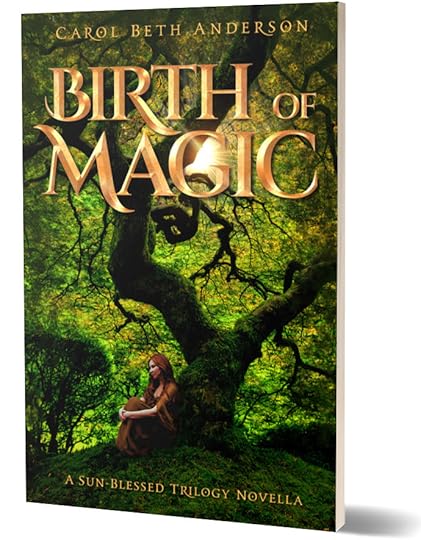
I love this new novella, which you can pick up as a free e-book on Amazon or at various other retailers. Or snag a signed paperback copy on my website!
Here’s the down-low on this new book:
It’s the prequel to the Sun-Blessed Trilogy, but the story stands on its own. Read it before or after the trilogy!It’s a novella, which is a short novel (about 1/3 the length of Facing the Sun.)What’s it about? A brothel’s no place for a teenager, but Kari doesn’t think she has any other options. When she finally flees, the brothel owners hunt her relentlessly. They won’t stop . . . but neither will she. You’ll love this new fantasy world with captivating magic, raw emotion, and page-turning intrigue.
I hope you’ll check it out!
January 6, 2019
Author Resource: Sales and Royalties Spreadsheet
Hi, fellow indie authors!
I’m really excited about the spreadsheet I’m sharing with you. I wanted a place to track all my sales from various venues.
You might find this spreadsheet useful if you are US-based, have fifteen or fewer book titles for sale, and sell these books in any or all of the ways below:
Amazon KDP (e-books, paperbacks, Kindle Unlimited)ACX (audiobooks)IngramSpark (paperbacks)Your own website (selling paperbacks, etc.)In-person sales (such as book signings)
You don’t have to sell in all those ways to use this tool; just leave the parts blank that you don’t need.
I’m geeking out over what this spreadsheet does. You’ll enter your book titles once, and they’ll be shown over and over throughout the sheet. You’ll paste in data from reports (such as the downloadable KDP sales report) once a month, and the spreadsheet will add it all up for you, even making the necessary calculations to convert from other currencies to U.S. dollars!
It doesn’t do everything for you! Like I said, you still have to paste in data. If you do in-person and/or website sales, it’ll take a little more work to enter those. But most of your work will happen once a month when you download and paste in data from your various reports, and that shouldn’t take longer than fifteen or twenty minutes once you get the hang of it.
The result? Data, data, data. Monthly and annual sales broken down by book and by where the sale happened (such as US, UK, or Other.) Charts, so you can see which books are performing the best, which months you make the most money, which book formats are earning you the most, and more.
Below are a couple of teaser images from the spreadsheet.
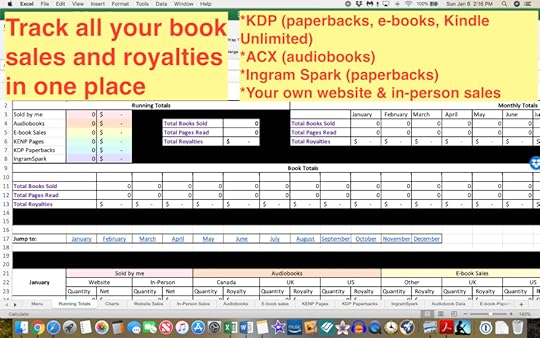
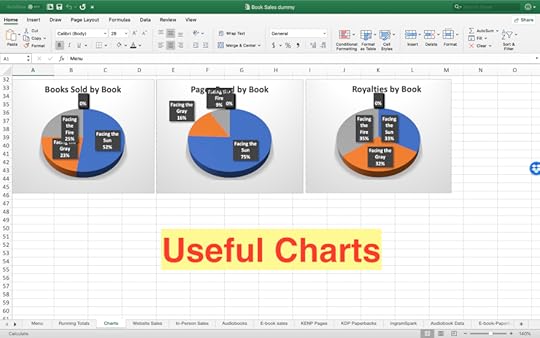
Ready to get started?
Click here to download the Book Sales and Royalties spreadsheet.
Click here to watch a half-hour YouTube video on how to use the tool.
Feel free to share this with others, preferably by pointing them to this blog post.
Author Resources on my website are 100% free. But if you’d like to buy me a coffee to thank me, click the button!
December 29, 2018
Author Resource: Trilogy Rapid Release Checklist
Hi, fellow authors! When I decided to rapid release a trilogy, including e-books, paperbacks, and audiobooks, I knew I needed to do it in an organized way!
I’d like to share the spreadsheet checklist I used to guide me. You’ll need to tweak it to fit your own business.
Next to many of the tasks on the checklist, there’s an “Info” link. Click on it, and it will take you to another page of the spreadsheet with links and other info to guide you.
Here’s a screenshot:
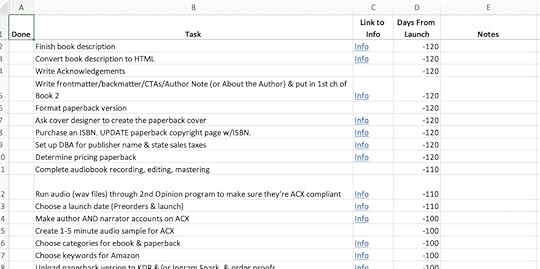
You can download your own copy from Dropbox by clicking here. If you don’t have Microsoft Excel, just download it and import it into Google Sheets or whatever other spreadsheet program you use.
Feel free to share this with others, preferably by pointing them to this blog post.
Happy writing . . . and publishing!
December 11, 2018
Author Resource: Word Count Spreadsheet
I’m starting a new blog series for fellow authors. I’ll share tools I use in my own writing and publishing business, all for free.
First, this is a simple spreadsheet to track the number of words your writing. It’s updated to include 2019. It’ll automatically add up your weekly (Sunday – Saturday), monthly, and annual totals. Just enter the number of words in the white cell next to the date, and it’ll do the work for you.
Screenshot of the spreadsheet:
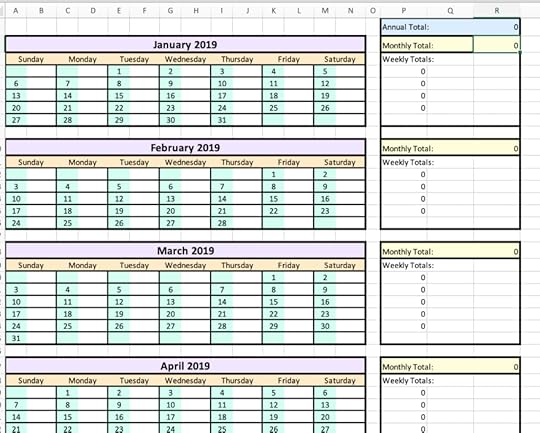
You can download your own copy from Dropbox by clicking here. If you don’t have Microsoft Excel, just download it and import it into Google Sheets or whatever other spreadsheet program you use.
Feel free to share this with others, preferably by pointing them to this blog post.
November 15, 2018
Three books, nineteen months. Facing the Fire is here!
Nineteen months ago, I decided to write a book. I thought I’d probably narrate and produce the audiobook, too.
It turned into a trilogy.
And as of today, all three of my babies are out there in the world.
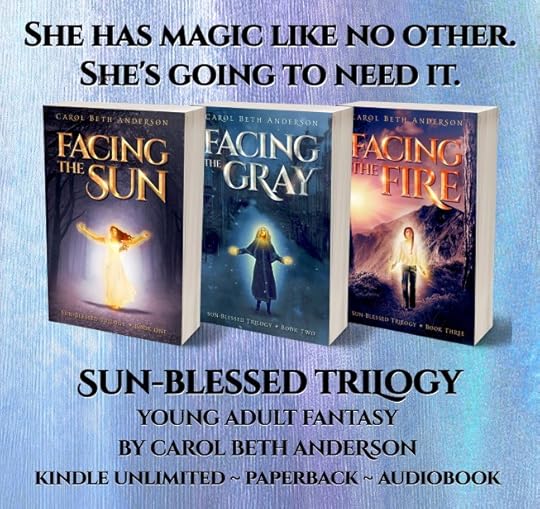
What a ride it’s been. It’s been joyful and stressful. Delightful and tiring. I’ve tried to balance my life and my art, often unsuccessfully. I’m learning as I go, and isn’t that part of what life’s all about?
I don’t know where this writing career will take me. But I’ve realized what a huge privilege and blessing it is to be able to pour my passion, my time, and my imagination into creating something. And I’m going to enjoy and appreciate that.
I write books.
What a wonderful thing.
*****
Oh, and just in case you don’t have your copies yet…
E-books: Amazon (exclusively)
All three audiobooks are now available on Audible (click here: Facing the Sun , Facing the Gray, Facing the Fire ) and you can also find them on Amazon and iTunes.
Paperback books: Amazon, Barnes & Noble (or request to special order from your local bookstore)
Signed paperbacks: carolbethanderson.com
November 1, 2018
Facing the Gray release day!
Facing the Gray, Book 2 in the Sun-Blessed Trilogy, is now available on Amazon and Audible!
This book has more action, more magic, and more “feels” than the first. I love Facing the Gray, and I hope you will too.
Check out Facing the Gray here:
Amazon (paperback, ebook, audiobook)
Audible (audiobook)
My website (signed copies)
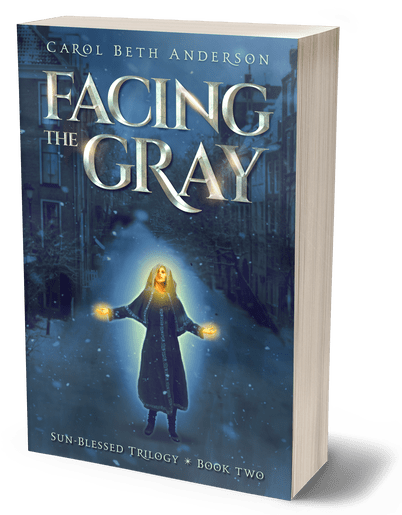
October 25, 2018
Facing the Sun Release Day!
Eighteen months (and a few days) ago, I started brainstorming to write my first novel.
Today…it’s here.
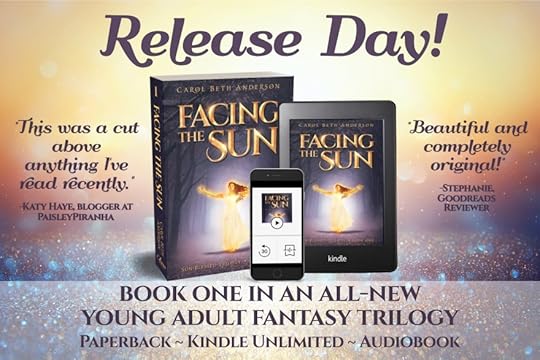
Check out Facing the Sun at these links:
Kindle E-book on Amazon (purchase, or read for free through your Kindle Unlimited subscription)
Paperback book: Amazon, Barnes & Noble
Audiobook on Audible, Amazon, or your iTunes app
Signed paperbacks at carolbethanderson.com
Publishing a book isn’t a one-woman job. Thank you to all of you who encouraged, critiqued, listened, and supported in so many other ways!
Read (or listen), review, and enjoy!



